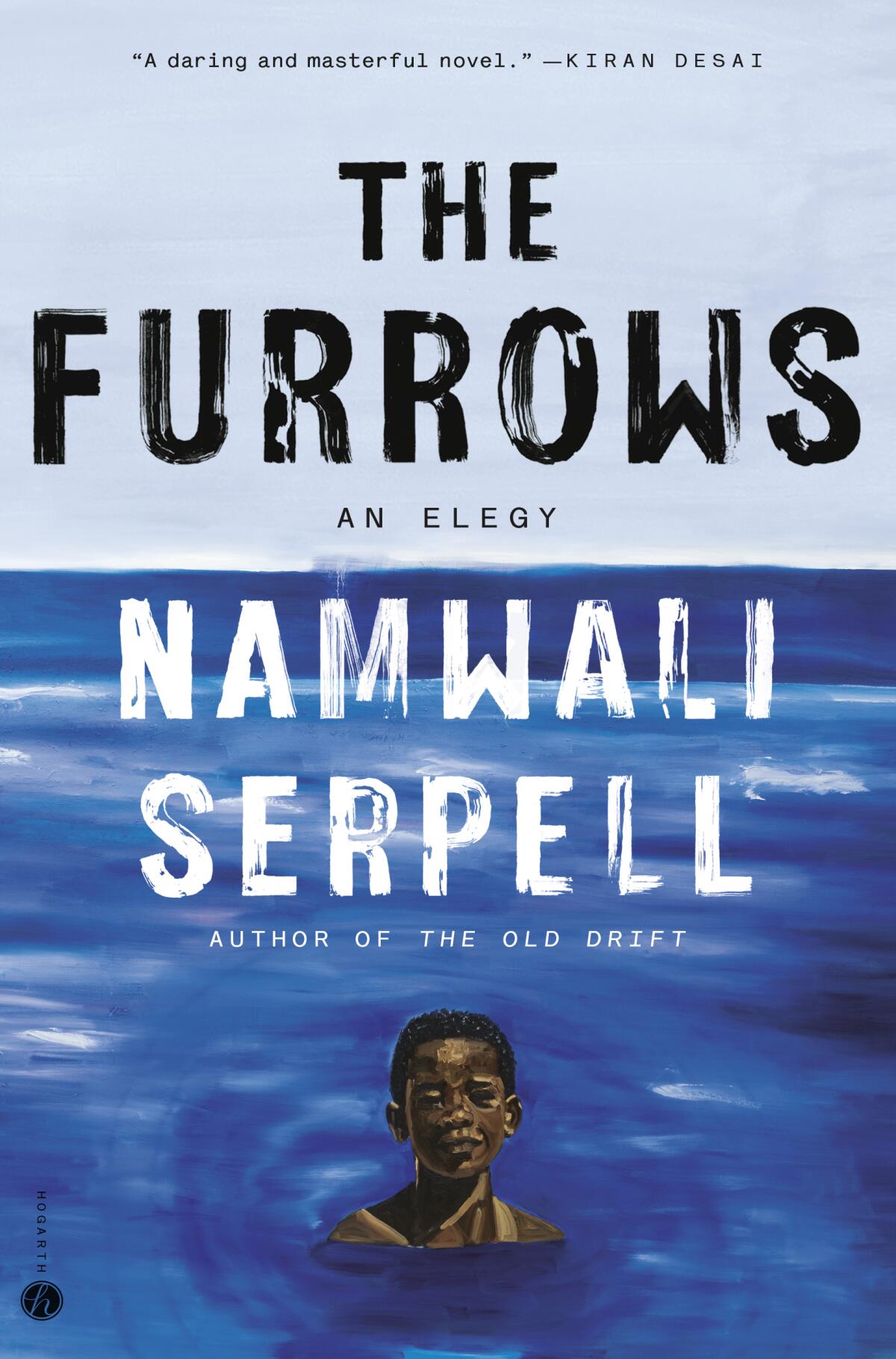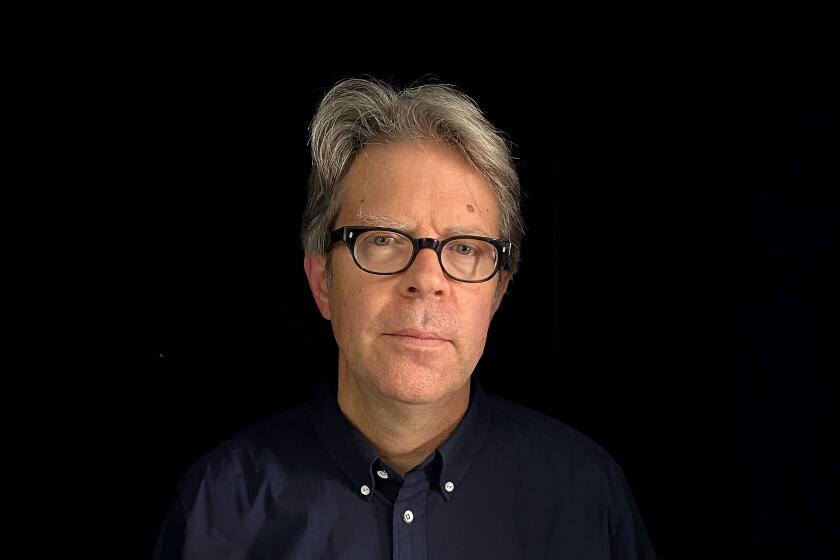Review: The follow-up to Namwali Serpell’s debut novel is less grand — and better for it

On the Shelf
'The Furrows'
By Namwali Serpell
Hogarth: 288 pages, $27
If you buy books linked on our site, The Times may earn a commission from Bookshop.org, whose fees support independent bookstores.
I have long been an admirer of Namwali Serpell’s criticism, but it feels worth noting at the outset that I struggled with her debut novel, “The Old Drift.” The mastery and brilliance were obvious. It was ambitious, polyphonic, multigenerational, compared (deservedly) both to Gabriel García Márquez and Salman Rushdie. There was no question, reading that book, of its dexterity and complexity, of the fact that Serpell’s brain was extraordinary. I chalked my ambivalence up to taste.
Taste is only so interesting in criticism. If I’ve done my job well, you’ll seldom know whether I liked a book or not. On the terms “The Old Drift” set out for itself, it was absolutely an accomplishment. Had I been assigned to write about it, I would have focused on all the ways, on its specific terms, it succeeded wildly. I bring in taste only to tell you that her second novel, “The Furrows,” out this week, is also a success on the terms it set out for itself. But it is a further testament to Serpell’s abilities and alacrity as an artist that, this time, I was completely in the thrall of the thing she made. The bombast of “The Old Drift” has been replaced with intimacy, intense emotionality and specificity, but the ambition, the acuity of the intelligence, remains.
The first sentences of “The Furrows”: “I don’t want to tell you what happened. I want to tell you how it felt.” Like all great first lines, they function as instructions for reading the whole book. The chapters unfold under a miasma of uncertainty. Cassandra’s brother Wayne disappears in the first chapter while the siblings are swimming in the ocean. She is 12 and he’s 7. There’s a white man with a blue windbreaker who might be there to help. Wayne’s body is never found.
The latest from Ling Ma, Yiyun Li, Russell Banks and Namwali Serpell as well as exciting newcomers round out our critics’ most anticipated fall books.
The book moves forward in time, then back again. Maybe drowning wasn’t the cause of Wayne’s death. The next chapter reimagines his disappearance as an accident on the walk to school; the next reimagines it again. The man in the blue windbreaker reappears. In each, the body is never found. Maybe Wayne didn’t die but only disappeared. Maybe the man sitting across from a grown Cassandra at a coffee shop is her brother, maybe that explosion that came crashing through the window of the coffee shop as they touched is just how seeing her grief again, touching it, felt. “It’s like swimming,” Cassandra thinks. “You stroke and kick to get to the outermost edge of the wave. You feel the momentum: go on go on go on. But always, something tugs you back into the scooped water, the furrows, those relentless grooves.”

What is fact in the novel’s world is that Cassandra’s parents divorce. Her Black father marries someone else. Her white mother starts a foundation, Vigil, with her inheritance to search for missing kids and support their parents. Eventually, Cassandra works for her. The solidity of these grounding facts is key to the book’s success. Serpell’s dexterity not only inside of sentences but inside the world, delivering just enough immutable truth to guide the reader along the wobbly tightrope, gives her that much more freedom to move balletically through different registers of feeling, space and time.
In the second half, the perspective shifts — as does the voice. We are with Wayne, likely not Cassandra’s brother but someone else in search of him, who looks like him. Cassandra meets him as they are, together, involved in an accident. Though all previous encounters with possible Waynes have ended quickly, often violently, this one ends with seduction, intimacy, desire (though its origins are also rooted in violence). And there is something here: Like her brother, this new Wayne was inside something with Cassandra, something fatally dangerous, but now, having both survived it, they are able to come together on the other side: “It makes a kind of sense, a returned favor: he waited for me; I’ll escort him home … Plus-plus who knows.”
Serpell’s engagement with grief grows in its layering as Wayne slips trickily into the first person previously occupied by Cassandra. Though Part II will begin a couple of pages later, it feels important that the “I” be taken over by Wayne after only a small section break, important that the tone shift very gradually into a very different voice.
For nearly 20 years, Namwali Serpell has been writing “The Old Drift.”
Until, many pages later, we settle into another, different shade of Wayne: “you can call me Will. That aint my real name. But close enough. Plus my real name’s brought me a whole lotta trouble in this life. I aint that man now anyway.” Here the book makes clear it’s interested as much in the slipperiness of containing and defining an individual self as it is in how that self is informed by loss. The unmooring intensifies. As the voice shifts, the reader has to continually recalibrate her expectations, continually reinvest in and reconsider all these different Waynes, these different types of loss.
This can be destabilizing and uncomfortable, but then so can grief; so can trying to situate all your conflicting histories and experiences into a single self. It is also stunningly intimate, always crystalline at the level of the individual sentences, which remain brisk, clipped, all image and solid, immediately inhabitable metaphor: “Wayne loved school. He was fawn brown, a gangly kid, the heat of growing still burning up all his fat … it was Spring, warm and bright, the air choked with flowers and furry seeds.”
Serpell is clear when she needs to be, opaque only when it matches how Cassandra or Wayne feels. “Time began to slip forward,” Cassandra thinks, “fast, faster, then at furious speed, propelling me through the night until my eyelids flipped open to a stopped dawn with no color at all.”
If “The Old Drift” put Serpell in conversation with Rushdie and García Márquez, “The Furrows” seems to stand on the shoulders of Virginia Woolf and Toni Morrison. Above all, Serpell is working with a confidence in and commitment to her project and to the story form. She understands what it is to always have hold of the reader. She does not pander or explain. Instead, the genius is in the book’s bones, its DNA. There is a sort of palimpsest of thinking, reading: The ideas have been churning in the writer for years, but the agony of that work is nowhere to be found. Instead, Serpell gives exactly what she tells us at the outset, a stunningly acute depiction of how the endless layers of both grief and absence, the impossibly slippery act of trying to be a person, feel.
His new novel, ‘Crossroads,’ is extraordinary, immersive, even fun. But it makes you wonder what Franzen might accomplish if more were at stake
Strong is a critic and the author of the forthcoming novel “Flight.”
More to Read
Sign up for our Book Club newsletter
Get the latest news, events and more from the Los Angeles Times Book Club, and help us get L.A. reading and talking.
You may occasionally receive promotional content from the Los Angeles Times.









